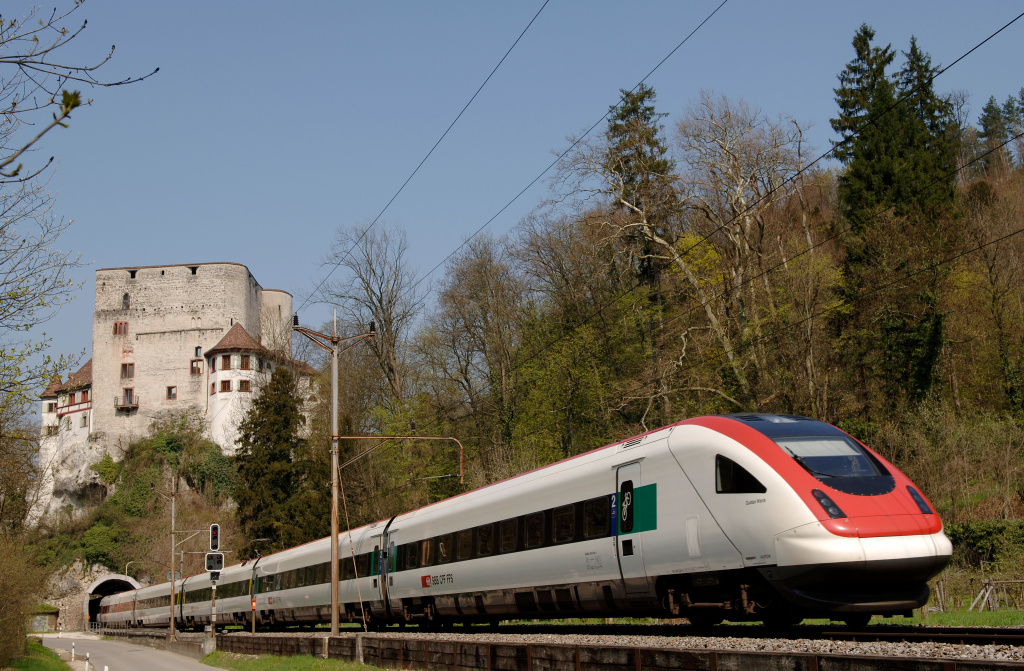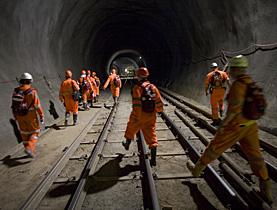Railway upgrades include no fast track

Switzerland has major plans to improve its rail infrastructure in a project that is considered crucial for the country’s future and its continuing competitiveness.
But it is already clear that high-speed trains play no part in Rail 2030 – the name of the new project.
A public transport expert at the Federal Institute of Technology in Zurich (ETHZ) has argued, to mix metaphors, that Switzerland should not miss the boat and has put forward the idea of building a high-speed rail link that could eventually go from St Gallen to Geneva.
Ulrich Weidmann, a professor who specialises in transport systems, told swissinfo.ch that Switzerland’s rail network was too slow.
“High-speed trains would connect the main economic centres of the country much better and improve collaboration between them,” he said.
He believes that if a new high-speed line were to be built, the journey time between Bern and Zurich, for example, could be reduced to around 40 minutes, about 15 minutes less than now.
And he says this would make the rail travel so attractive that it would persuade people to shift from cars, and would increase revenues and productivity.
No future here
However, unless the Swiss authorities do a 180-degree turn, high-speed trains have no future here.
“Most passengers travel a distance of about 100km, for example between Bern and Zurich or between Geneva and Lausanne. The main problem here is the capacity and not the speed,” Max Friedli, director of the Federal Transport Office, told swissinfo.ch.
Weidmann is not convinced. “It’s always said that we only travel short distances in Switzerland. That’s probably correct at the moment but we’re talking about the year 2040 to 2050 and I suggest that [journeys over longer] distances will increase during this time.”
He thinks that high-speed trains could shave about an hour off the current journey time between St Gallen and Geneva.
There are plenty of people, particularly commuters, who would agree with Friedli that the capacity issue has become a major headache, particularly at peak times when standing is not uncommon.
In outlining Rail 2030 plans on Tuesday in Bern, Friedli addressed the main areas where improvements would be made.
More and more
“We want to have more seats in the trains, we want more trains especially in the mornings and evenings, and we would like to modernise our railway stations,” he said.
Stations need bigger platforms to cope with longer trains and more room to deal with the ever-increasing number of people who are switching to rail transport.
The main stumbling block will be the financing of Rail 2030, with two scenarios put forward for discussion.
One foresees the spending of SFr21 billion ($19.8 billion). This would provide more trains on the highly frequented east-west axis, bring improvements to regional traffic in built-up areas and rural zones, as well as adapting freight traffic to increasing demand.
Investments of SFr12 billion are needed for a less ambitious project that would place less emphasis on the development of regional traffic.
Taxing issue
A whole list of tax increases are to be examined and passengers will also be expected to dig deeper into their pockets.
The chief executive of the Swiss Federal Railways, Andreas Meyer, said the finance question should also be seen in the light of Switzerland’s leading competitive position, with the country’s high-quality public transport a contributing factor.
He has another priority: “We cannot have compromises when it comes to quality and security.”
Friedli is optimistic that the higher sum can be raised, albeit in “typical” Swiss fashion by finding common ground and putting it to a vote.
“I think the chances for the project of SFr21 billion are better than those for the SFr12 billion because the SFr21 billion will allow us to improve our transport system in all regions of the country. With the SFr12 billion, we would only have them on the east-west axis.
“All that requires a modification of the constitution, so it needs a ‘yes’ from the people and a ‘yes’ from the cantons. The big question is whether we can find a typical Swiss compromise,” he said.
The Rail 2030 now goes to Swiss cantons for their opinions before being sent for consultation around the country.
Robert Brookes, swissinfo.ch
The Swiss are the world champions when it comes to taking the train – last year they travelled on average 2,422km per person by rail, according to figures of the Swiss Information Service for Public Transport at the end of September. These drew on International Union of Railways figures for 2008.
This is 300km more than in 2007. Only the Japanese come close to the Swiss total at 2,010km, with France in third place at 1,377km. Trains are least used in Lithuania at only 112km per person in 2008.
The Swiss top the European list in terms of number of times the train is taken, at 50 times per annum. The Japanese lead the world rankings at around 70 times a year.
There are two main reasons for heavy investment in Swiss railways: Switzerland’s topography places natural limits to the extension of the road network, especially the transit goods transport through the Alps.
And the Swiss constitution stipulates that transit goods transport from north to south Europe should travel by rail, as far as possible.
The New Rail Link through the Alps includes two new major tunnels, the Lötschberg (34.6km) which was opened for scheduled traffic in 2007 and the Gotthard, which at 57km, will be the longest rail tunnel in the world. It is not expected to open until 2017.
This was an ambitious high-speed underground rail project that was considered in detail from the 1990s. Lack of financing and political will led to the disbanding of the company last year.
Swissmetro wanted to run underground magnetic levitation trains that would link the main Swiss cities.
The idea was for Swissmetro stations to be built directly beneath or very close to the main central train stations, where passengers could easily transfer to the existing transport network.
The plan was that in peak hours, a Swissmetro train would run every six minutes with speeds of up to 500km/h. The trip from Zurich to Bern would take 12 minutes, and from Geneva to St Gallen one hour.
It boasted that the impact on the environment was minimal. There would be no noise, no effects on the landscape, and because of the reduced aerodynamic drag in the decompressed tunnel, there would be little energy consumption.

In compliance with the JTI standards
More: SWI swissinfo.ch certified by the Journalism Trust Initiative













You can find an overview of ongoing debates with our journalists here . Please join us!
If you want to start a conversation about a topic raised in this article or want to report factual errors, email us at english@swissinfo.ch.